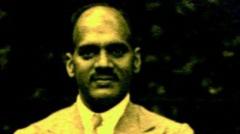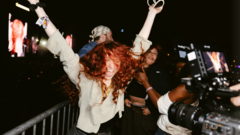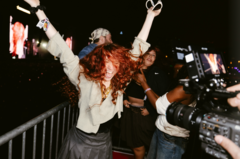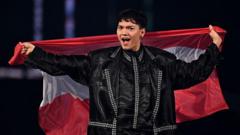Throughout the whirlwind of the Eurovision Song Contest, an unseen team operates like a finely tuned engine, executing precise movements within a mere thirty-five seconds. These methodical individuals are tasked with transforming the stage between acts, ensuring that props are set, microphones are ready, and every detail is in place for flawless performances.
Richard van Rouwendaal, the stage manager, likens this rapid set switch to a Formula 1 tire change, where each team member is responsible for a single element—be it a lighting fixture or a prop. Any deviation from a specified path could create chaos onstage, making precision the name of the game.
As the crew prepares for their fast-paced choreography weeks before the competition, each participating country submits detailed staging plans. Practice sessions with stand-ins from local performing arts schools in Liverpool allow the team to virtually shave seconds off their tasks, bringing down the time needed to execute transitions.
Over two weeks of rehearsals, van Rouwendaal assembles a mix of Dutch professionals and local talent. Each team member's unique abilities—whether sprinting, lifting, or organizing—are integral to this complex puzzle that blends artistry with logistics. "You have to line everything up perfectly in a small space, like playing Tetris," he explains.
In this choreographed chaos, the crew often find themselves cleaning the stage between performances as part of a dedicated effort to maintain an immaculate appearance for the viewing audience. The cleanliness of the stage is vital; unexpected marks can detract from the performance, especially during overhead shots.
Microphone stands are meticulously adjusted to the desired height for each artist to avoid mishaps, and any last-minute changes, such as altered footwear, can throw a wrench into this carefully curated setup.
The backstage area presents its own challenges, especially when props become increasingly elaborate over the years. The evolution of Eurovision staging has seen growing spectacles, with countries employing everything from giant hamster wheels to complex scenery. This year, organizers have even prepared for spontaneous changes in props through clever use of concealed passageways.
“It's a logistical effort to ensure everything runs smoothly,” says Damaris Reist, the deputy production head. There are several secret routes that facilitate the swift in-and-out movement of props. Yet, when things go awry, like a broken camera or malfunctioning equipment, contingency plans are in place, including pre-recorded footage ready to be switched in as necessary.
Amid the stress of live broadcast challenges, the crew has been granted measures promoting mental well-being, including longer breaks and restricted areas away from prying eyes. Despite these pressures, the team seeks a balance, sharing moments of camaraderie with treats and laughter.
As the event approaches its climax, van Rouwendaal reflects on the intense preparation and the joy found within the chaos. The hard work of the visible performers often shrouds the indispensable contributions of the backstage “invisible crew,” who strive to ensure each act dazzles without revealing the effort behind the scenes. Ultimately, if everything goes according to plan, their behind-the-scenes presence should remain just that: behind the scenes.
Richard van Rouwendaal, the stage manager, likens this rapid set switch to a Formula 1 tire change, where each team member is responsible for a single element—be it a lighting fixture or a prop. Any deviation from a specified path could create chaos onstage, making precision the name of the game.
As the crew prepares for their fast-paced choreography weeks before the competition, each participating country submits detailed staging plans. Practice sessions with stand-ins from local performing arts schools in Liverpool allow the team to virtually shave seconds off their tasks, bringing down the time needed to execute transitions.
Over two weeks of rehearsals, van Rouwendaal assembles a mix of Dutch professionals and local talent. Each team member's unique abilities—whether sprinting, lifting, or organizing—are integral to this complex puzzle that blends artistry with logistics. "You have to line everything up perfectly in a small space, like playing Tetris," he explains.
In this choreographed chaos, the crew often find themselves cleaning the stage between performances as part of a dedicated effort to maintain an immaculate appearance for the viewing audience. The cleanliness of the stage is vital; unexpected marks can detract from the performance, especially during overhead shots.
Microphone stands are meticulously adjusted to the desired height for each artist to avoid mishaps, and any last-minute changes, such as altered footwear, can throw a wrench into this carefully curated setup.
The backstage area presents its own challenges, especially when props become increasingly elaborate over the years. The evolution of Eurovision staging has seen growing spectacles, with countries employing everything from giant hamster wheels to complex scenery. This year, organizers have even prepared for spontaneous changes in props through clever use of concealed passageways.
“It's a logistical effort to ensure everything runs smoothly,” says Damaris Reist, the deputy production head. There are several secret routes that facilitate the swift in-and-out movement of props. Yet, when things go awry, like a broken camera or malfunctioning equipment, contingency plans are in place, including pre-recorded footage ready to be switched in as necessary.
Amid the stress of live broadcast challenges, the crew has been granted measures promoting mental well-being, including longer breaks and restricted areas away from prying eyes. Despite these pressures, the team seeks a balance, sharing moments of camaraderie with treats and laughter.
As the event approaches its climax, van Rouwendaal reflects on the intense preparation and the joy found within the chaos. The hard work of the visible performers often shrouds the indispensable contributions of the backstage “invisible crew,” who strive to ensure each act dazzles without revealing the effort behind the scenes. Ultimately, if everything goes according to plan, their behind-the-scenes presence should remain just that: behind the scenes.





















